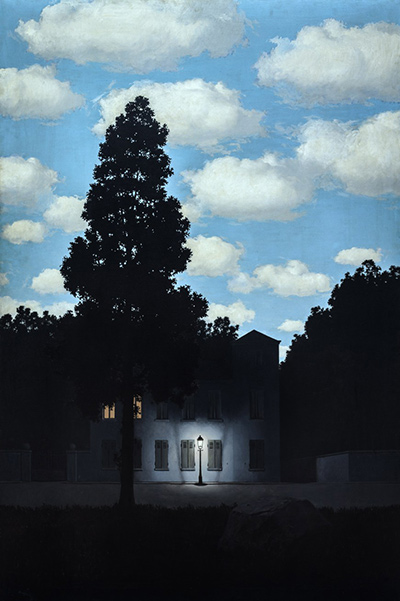The Empire of Light or as it is known in French L'Empire des lumières was painted by the surrealist Belgian artist, René Magritte. He created these famous works between the years of 1953 to 54.
The artistic creations of Magritte are often described as magic realism, as they explore everyday objects, familiar scenes and people, but through an entirely different lens and viewpoint. His paintings are often direct, bold in their depiction and disturbing, which means that his art makes a dramatic impact upon the observer.
His Empire of Light, is in fact a series of paintings, all of which are created as oil on canvas depictions of the same and similar scene, that of a house on a steer street painted during the daytime, that is lined with trees, although the image is dark and only lit by one lonely streetlight. The image is probably best known as that of the iconic film still from the 1973 cinematic film, The Exorcist. The image from the film is that of Father Merrin, as he stands underneath a lonely street lamp outside the home of the MacNeil family.
There are several paintings that exist, all of which are slightly different from each other. One painting is housed in New York, in the Museum of Modern Art, and another in the Musées Royaux des Beaux-Arts de Belgique in Brussels. What all variations of Empire of Light depict, is a street scene that is painted amongst a pale blue sky, encrusted with many white clouds. Unlike Magritte's other paintings, that are fantastical in both style and colour, Magritte chose to keep The Empire of Light incredibly simple, with only one element of fantasy, that of painting a street scene that both depicts night and day. This juxtaposition both entrances and confuses the observer. Are we viewing a daytime scene that is simply slightly gloomy? Or are we observing a nighttime scene that is illuminated by the single streetlight? This is the true beauty of the image, as it can, and is indeed, both an image of day and nighttime fused as one.
The sky in The Empire of Light has been painted in an incredibly unsettling light. The luminous sky appears as uninviting and cold, even though it is lit and the darkness that surrounds the light is something to be feared. The interesting aspect of the image is that it is impersonal, it lacks soul and feeling. This is very much in keeping with the surrealist artistic movement of its day.
The feeling of coolness and the fact that the entire image is devoid of human emotion, is depicted in the fact that the house in the street is in complete darkness, apart from the light that is cast upwards from the streetlamp and a few lights that are present in seemingly empty rooms. This coolness, and feeling of unease, is further explored in the fact that the house appears to be painted in the daytime, but appears as it would during the night. Day and night are present together as one on the canvas. This is incredibly unnerving for those who observe the painting.
The Empire of Light confuses the observer on two levels. The observer is confused on a visual level, as what we see with our eyes cannot be true in real life, as day and night cannot exist together. On a deeper level, we are confused on a moral level. The light representing good, and the darkness evil. Can light and dark exist together? Perhaps the painting is depicting the forces of purity and evil, and that the two can exist side by side in everyday reality. What we feel as we observe this image though is that of overwhelming darkness, unease and that something bad is about to happen. Perhaps the light in the picture does intact represent purity, and that the evil that is lurking, will in fact be beaten and driven away?
The two light sources within the painting also juxtapose each other and wrestle with the observer's emotions. There is the natural light as opposed to the artificial street light. Nature versus man, the warmth of nature as opposed to the harshness of artificial and false light. Once again, the notion of purity and evil are depicted in the painting of light within the image.




